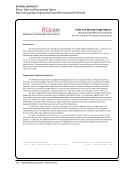182 · Representative Documents: Workflows
University of Virginia
AIMS Whitepaper. Appendix E: Sample Processing Plans
http://www2.lib.virginia.edu/aims/whitepaper/AIMS_final_appE.pdf
Desired Processing: All computer media should be processed. Additionally, all accessions should be
combined into a single finding aid. Where EAD exists, these records will be com-
bined into a single archdesc and dsc with each accession being represented
as a series. The accessions represented by MARC records will be converted to
series components. In addition, subject headings, which were not included in the
original EAD, should be added from all MARC records.
No further work will be done with paper materials at this time.
The processor will create disk images of the disks and then process using FTK.
Disks containing commercial works that were used for research purposes should
not be imaged or stored at this time. Individual files will be labeled with the disk
number so that they may later be associated with the correct container element
in the EAD. Titles of individual works will be added to the finding aid so that some
reference to the works available on the disks is present. This is to match the level
of processing of the paper manuscripts, which are indicated by name within the
collection descriptions.
Files containing confidential information will be completely restricted at this time.
Obsolete file formats will not be migrated at this time, but this work should be
considered in the future. Access to materials on the disk will be at the individual
file level. After imaging the disk a copy of the image will be transferred to the
StoreNext preservation store. Copies of the unrestricted files will be added to
the Hypatia repository for public access.
The disk images will be referenced by identifier number within the ead. They will
exist as individual subcomponents of the accession or sub-series (if it exists) and
the disk number will be referenced in a “unitid” attribute. The finalized finding aid
will also be uploaded into the Hypatia repository and the individual files will be
linked to the accession or container they belong to.
Next steps Reprocessing all accessions into one collection arranged intellectually, rather than
intellectually within individual accessions, is recommended for the future when the
collection is deemed “complete.” As technology and infrastructure develop, migra-
tion of obsolete formats and redaction within restricted files in order to make
them available should also be undertaken.
Notes to Processors: Examine the contents of the CDs later in the series to determine which are sim-
ply copies of commercially produced works and do not need to be imaged.
Anticipated Time for Proc-
essing:
5 days
AIMS: An Inter-Institutional Model for Stewardship
Appendix E: Sample Processing Plans 10
University of Virginia
AIMS Whitepaper. Appendix E: Sample Processing Plans
http://www2.lib.virginia.edu/aims/whitepaper/AIMS_final_appE.pdf
Desired Processing: All computer media should be processed. Additionally, all accessions should be
combined into a single finding aid. Where EAD exists, these records will be com-
bined into a single archdesc and dsc with each accession being represented
as a series. The accessions represented by MARC records will be converted to
series components. In addition, subject headings, which were not included in the
original EAD, should be added from all MARC records.
No further work will be done with paper materials at this time.
The processor will create disk images of the disks and then process using FTK.
Disks containing commercial works that were used for research purposes should
not be imaged or stored at this time. Individual files will be labeled with the disk
number so that they may later be associated with the correct container element
in the EAD. Titles of individual works will be added to the finding aid so that some
reference to the works available on the disks is present. This is to match the level
of processing of the paper manuscripts, which are indicated by name within the
collection descriptions.
Files containing confidential information will be completely restricted at this time.
Obsolete file formats will not be migrated at this time, but this work should be
considered in the future. Access to materials on the disk will be at the individual
file level. After imaging the disk a copy of the image will be transferred to the
StoreNext preservation store. Copies of the unrestricted files will be added to
the Hypatia repository for public access.
The disk images will be referenced by identifier number within the ead. They will
exist as individual subcomponents of the accession or sub-series (if it exists) and
the disk number will be referenced in a “unitid” attribute. The finalized finding aid
will also be uploaded into the Hypatia repository and the individual files will be
linked to the accession or container they belong to.
Next steps Reprocessing all accessions into one collection arranged intellectually, rather than
intellectually within individual accessions, is recommended for the future when the
collection is deemed “complete.” As technology and infrastructure develop, migra-
tion of obsolete formats and redaction within restricted files in order to make
them available should also be undertaken.
Notes to Processors: Examine the contents of the CDs later in the series to determine which are sim-
ply copies of commercially produced works and do not need to be imaged.
Anticipated Time for Proc-
essing:
5 days
AIMS: An Inter-Institutional Model for Stewardship
Appendix E: Sample Processing Plans 10










































































































































































































